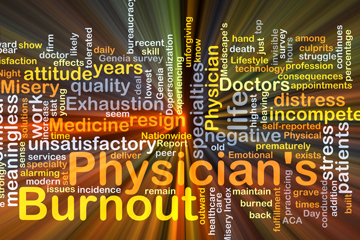 As a medical transcription company with years of experience in the industry, we are well aware of the problem of physician burnout. In addition to affecting physicians, burnout is linked to lower quality of care, lower patient satisfaction, increased risks of medical errors and higher rates of physician turnover. We have written about the role of medical transcriptionists in reducing physician stress and burnout. However, burnout is not just about the burden of clinical documentation. A recent article in Medical News Today says that physicians at all stages of education and training face risk for burnout. Studies report that up to 25 to 50% of medical students experience depression and anxiety, and that half report symptoms of burnout. The Advisory Board notes that more than half of US physicians are now experiencing professional burnout.
As a medical transcription company with years of experience in the industry, we are well aware of the problem of physician burnout. In addition to affecting physicians, burnout is linked to lower quality of care, lower patient satisfaction, increased risks of medical errors and higher rates of physician turnover. We have written about the role of medical transcriptionists in reducing physician stress and burnout. However, burnout is not just about the burden of clinical documentation. A recent article in Medical News Today says that physicians at all stages of education and training face risk for burnout. Studies report that up to 25 to 50% of medical students experience depression and anxiety, and that half report symptoms of burnout. The Advisory Board notes that more than half of US physicians are now experiencing professional burnout.
To tackle the problem, it is necessary to understand the key drivers for physician stress and burnout:
High demands of training: It is reported that high demands of residency and fellowship training are the major reasons for depression symptoms and burnout at student level.
Increased regulatory burden: Confusing and burdensome regulatory programs encroach into the critical time physicians could be spending to provide high-quality care for their patients. The Advisory Board reports that each week, a physician spends around 11 hours on non-clinical paperwork each week.
Excessive workload and extended time at work: A 2014 survey from the Physicians Foundation found that 81% of physicians spent too many hours at work. The Advisory Board survey found that only 14% of physicians felt they had the time they need to provide the highest standard of care.
Increasing computerization: One of the main reasons for increase in burnout rates during the period from 2013 to 2015 was “increasing computerization of practice”, reports Medscape. EHRs offer many benefits but have made clinical data entry burdensome for physicians. In fact, in a 2014 Medscape survey 70% of physicians said that the EHR decreased their face-to-face time with patients, and 57% noted that it affected their ability to see patients. Moreover, EMRs enable patients to contact their physician directly via messaging. Physicians are expected to provide information outside of scheduled clinic visits through these systems.
Compromised decision-making: Clinical decision making is a keystone of high-quality care, especially in fields like emergency medicine. However, 69% of the respondents in the Advisory Board survey reported that their clinical autonomy is occasionally or often restricted, and that their decisions may be compromised.
Emotional and physical exhaustion: Studies have found that physicians who become emotionally exhausted become stressed. Lack of control over schedules and time can lead to poor sleep patterns, interfere with family activities and events, and poor self-care, all of which cause physical and emotional exhaustion, resulting in burnout.
Patients: Medical News Today reports that striving for high patient satisfaction scores is a driver of physician burnout. Physicians could end up with low scores for reasons such as not prescribing antibiotics (even if it is not indicated), not providing a controlled substance at the patient’s request, or not ordering unnecessary laboratory tests. Clinicians are expected to handle difficult patients with drug-seeking, noncompliant, or even threatening behavior.
A 2016 NEJM Catalyst survey found that 96% of executives, clinical leaders, and clinicians consider physician burnout a serious or moderate problem in the health care industry. In the Physicians Practice 2016 Great American Physician (GAP) Survey, 1,314 physicians reported that the profession as being more stressful and less financially profitable than in the past. With an impending physician shortage and demand for access on the rise, the entire health care industry needs to work together to find a solution to the problem of physician stress and burnout. The good news is that experts have put forward various measures to mitigate the problem.
Organization-directed interventions: The first step to overcoming physician burnout at the organization level is to identify and understand the root causes. Leaders must conduct a thorough survey to assess the problem and then take corrective action. Institutional support can include optimizing physician workflows, reducing EHR burdens, and increasing physician time for direct patient care. These organizational interventions can have a positive impact on burnout. Organizations also need to track whether these changes are making a difference.
Giving physicians an active role in decision making: This is also an intervention that needs to be implemented at the organizational level. The Advisory Board reiterates that where appropriate, physicians must be given an option in how new initiatives affect their day-to-day practice and work-life balance. This will show that their views on a new initiative were taken into consideration.
 Physician-directed approaches: These include interventions targeting individuals such as mindfulness or cognitive behavioral techniques to improve coping, communication, and competence. Medscape reports that a study found that PCPs benefited from mental training. After an attending a program consisting of a nonresidential weekend immersion along with two short follow-up evening sessions, PCPs reported significant reductions in burnout, depression, anxiety, and stress which were sustained at the end of the study 9 months after the intervention. The study described mindfulness as “mental training that enables one to attend to aspects of experience in a nonjudgmental, nonreactive way, which in turn helps cultivate clear thinking, equanimity, compassion, and open-heartedness.”
Physician-directed approaches: These include interventions targeting individuals such as mindfulness or cognitive behavioral techniques to improve coping, communication, and competence. Medscape reports that a study found that PCPs benefited from mental training. After an attending a program consisting of a nonresidential weekend immersion along with two short follow-up evening sessions, PCPs reported significant reductions in burnout, depression, anxiety, and stress which were sustained at the end of the study 9 months after the intervention. The study described mindfulness as “mental training that enables one to attend to aspects of experience in a nonjudgmental, nonreactive way, which in turn helps cultivate clear thinking, equanimity, compassion, and open-heartedness.”
Increase physicians’ time with patients: The AMA’s STEPS Forward program refocuses physicians towards spending more time directly caring for patients. The educational modules of the program are aimed at tackling common practice challenges, frequently focused on increasing physician productivity. For instance, one module focuses on optimizing staff performance and increasing the responsibilities of clinical staff before and after the physician component of the visit.
Emotional support: Physicians need professional support to cope with emotional stressors. There is the need to create a safe space so that they can seek mental health support without fear of reprisal. Physicians should be encouraged to communicate their frustrations and educated on tactics that can promote personal healing.
Studies have found that the ability to control work hours and schedule play an important role in reducing stress, improving career satisfaction, and reducing burnout. In one study, physicians reported that learning to set limits improved their sense of well-being and productivity. Physicians also need to take time out to relax, take breaks for meals and exercise, and be with their family.
The 2016 Catalyst NEJM survey found that clerical burden due to expanded and more comprehensive use of electronic health records is the leading cause of physician burnout. Medical transcription outsourcing is the ideal option to deal with clinical documentation tasks. US based medical transcription companies provide customized EHR-integrated align with practice workflow, improve care, and reduce physicians’ stressful clinical data entry tasks.


